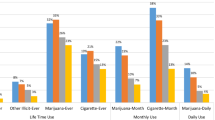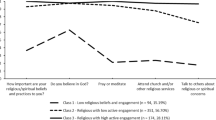Abstract
Purpose
This longitudinal study aimed to identify variation by race in the associations between religious involvement and initiation of alcohol, cigarette, and marijuana use, including distinctions by substance or type of religious involvement, in Black and White adolescent girls.
Methods
Data were drawn from interviews conducted at ages 11 through 17 with 2172 Pittsburgh Girls Study participants (56.8% Black; 43.2% White). Two indicators of public religious involvement, religious service attendance and participation in other religious activities, and two indicators of private religious involvement, prayer, and importance of religion were queried. A series of Cox proportional hazards regression analyses were conducted to identify independent effects of religious involvement indicators on initiation of each substance.
Results
Prior to adjusting for socioenvironmental and psychosocial factors (e.g., parental monitoring), importance of religion predicted initiation of alcohol use across race and cigarette and marijuana use in White but not Black girls. Participation in other religious activities also predicted marijuana use initiation only in White girls. In adjusted models, importance of religion remained significant for cigarette use initiation in White girls (hazard ratio [HR] = 0.68, 95% confidence intervals [CI]: 0.53–0.88) and participation in other religious activities remained significant for marijuana use initiation in White girls (HR = 0.63, CI: 0.47–0.83).
Conclusions
The protective effects of religious involvement against cigarette and marijuana use initiation are more robust for White than Black adolescent girls and overall relatively weak for alcohol use initiation. Furthermore, importance placed on religion may be a better indicator than religious service attendance of risk for adolescent substance use initiation.
Similar content being viewed by others
References
Koenig HG, King D, Carson VB (2012) Handbook of religion and health, 2nd edn. Oxford University Press, New York
Weaver AJ, Flannelly KJ, Strock AL (2005) A review of research on the effects of religion on adolescent tobacco use published between 1990 and 2003. Adolescence 40:761–776
Miller L, Davies M, Greenwald S (2000) Religiosity and substance use and abuse among adolescents in the National Comorbidity Survey. J Am Acad Child Adolesc Psychiatry 39:1190–1197
Nonnemaker JM, McNeely CA, Blum RW (2003) Public and private domains of religiosity and adolescent health risk behaviors: evidence from the National Longitudinal Study of Adolescent Health. Soc Sci Med 57:2049–2054
Pitel L, Geckova AM, Kolarcik P, Halama P, Reijneveld SA, van Dijk JP (2012) Gender differences in the relationship between religiosity and health-related behaviour among adolescents. J Epidemiol Commun Health 66:1122–1128
Wallace JM Jr, Delva J, O'Malley PM, Bachman JG, Schulenberg JE, Johnston LD, Stewart C (2007) Race/ethnicity, religiosity and adolescent alcohol, cigarette and marijuana use. Soc Work Public Health 23:193–213
Nonnemaker J, McNeely CA, Blum RW (2006) Public and private domains of religiosity and adolescent smoking transitions. Soc Sci Med 62:3084–3095
Steinman KJ, Ferketich AK, Sahr T (2008) The dose–response relationship of adolescent religious activity and substance use: variation across demographic groups. Health Educ Behav 35:22–43
Wills TA, Yaeger AM, Sandy JM (2003) Buffering effect of religiosity for adolescent substance use. Psychol Addict Behav 17:24–31
Agrawal A, Grant JD, Haber JR, Madden PAF, Heath AC, Bucholz KK, Sartor CE (2017) Differences between White and Black young women in the relationship between religious service attendance and alcohol involvement. Am J Addict 26:437–445
Hayatbakhsh R, Clavarino A, Williams GM, Najman JM (2014) Maternal and personal religious engagement as predictors of early onset and frequent substance use. Am J Addict 23:363–370
Brown TL, Parks GS, Zimmerman RS, Phillips CM (2001) The role of religion in predicting adolescent alcohol use and problem drinking. J Stud Alcohol 62:696–705
Johnston LD, Miech RA, O’Malley PM, Bachman JG, Schulenberg JE, Patrick ME (2018) Monitoring the Future National Survey results on drug use: 1975–2017: overview, key findings on adolescent drug use. Institute for Social Research, Ann Arbor
Hill PC, Pargament KI (2003) Advances in the conceptualization and measurement of religion and spirituality: implications for physical and mental health research. Am Psychol 58:64–74
Salas-Wright CP, Vaughn MG, Maynard BR, Clark TT, Snyder S (2017) Public or private religiosity: which is protective for adolescent substance use and by what pathways? Youth Soc 49:228–253
Mason MJ, Schmidt C, Mennis J (2012) Dimensions of religiosity and access to religious social capital: correlates with substance use among urban adolescents. J Prim Prev 33:229–237
Nguyen NN, Hewill CE (2016) The role of religiosity as a protective factor against marijuana use among African American, White, Asian, and Hispanic adolescents. J Subst Use 21:547–552
Blum RW, Beuhring T, Shew ML, Bearinger LH, Sieving RE, Resnick MD (2000) The effects of race/ethnicity, income, and family structure on adolescent risk behaviors. Am J Public Health 90:1879–1884
Franzini L, Ribble JC, Wingfield KA (2005) Religion, sociodemographic and personal characteristics, and self-reported health in Whites, Blacks, and Hispanics living in low-socioeconomic status neighborhoods. Ethnic Dis 15:469–484
Pew Research Center (2017) In America, does more education equal less religion?
Shih RA, Parast L, Pedersen ER, Troxel WM, Tucker JS, Miles JNV, Kraus L, D'Amico EJ (2017) Individual, peer, and family factor modification of neighborhood-level effects on adolescent alcohol, cigarette, e-cigarette, and marijuana use. Drug Alcohol Depend 180:76–85
Tucker JS, Pollard MS, de la Haye K, Kennedy DP, Green HD Jr (2013) Neighborhood characteristics and the initiation of marijuana use and binge drinking. Drug Alcohol Depend 128:83–89
Corwyn RF, Benda BB (2000) Religiosity and church attendance: the effects on use of "hard drugs" controlling for sociodemographic and theoretical factors. Int J Psychol Relig 10:241–258
Steinberg L, Fletcher A, Darling N (1994) Parental monitoring and peer influences on adolescent substance use. Pediatrics 93:1060–1064
Van Ryzin MJ, Fosco GM, Dishion TJ (2012) Family and peer predictors of substance use from early adolescence to early adulthood: an 11-year prospective analysis. Addict Behav 37:1314–1324
Bartkowski JP, Xu XH, Levin ML (2008) Religion and child development: evidence from the Early Childhood Longitudinal Study. Soc Sci Res 37:18–36
Groenman AP, Janssen TWP, Oosterlaan J (2017) Childhood psychiatric disorders as risk factor for subsequent substance abuse: a meta-analysis. J Am Acad Child Adolesc Psychiatry 56:556–569
Krueger RF, Hicks BM, Patrick CJ, Carlson SR, Iacono WG, McGue M (2002) Etiologic connections among substance dependence, antisocial behavior, and personality: modeling the externalizing spectrum. J Abnorm Psychol 111:411–424
Smith C, Denton ML, Faris R, Regnerus M (2002) Mapping American religious participation. J Sci Study Relig 41:597–612
Oman RF, Vesely S, Aspy CB, McLeroy KR, Rodine S, Marshall L (2004) The potential protective effect of youth assets on adolescent alcohol and drug use. Am J Public Health 94:1425–1430
Hipwell AE, Loeber R, Stouthamer-Loeber M, Keenan K, White HR, Kroneman L (2002) Characteristics of girls with early onset disruptive and antisocial behaviour. Crim Behav Ment Health 12:99–118
Keenan K, Hipwell A, Chung T, Stepp S, Stouthamer-Loeber M, Loeber R, McTigue K (2010) The Pittsburgh Girls Study: overview and initial findings. J Clin Child Adolesc 39:506–521
Loeber R, Farrington D, Stouthamer-Loeber M, Van Kammen W (1998) Antisocial behavior and mental health problems: explanatory factors in childhood and adolescence. Lawrence Erlbaum Associates, Mahwah
Gorman-Smith D, Tolan PH, Henry D (2000) A developmental-ecological model of the relation of family functioning to patterns of delinquency. J Quant Criminol 16:169–198
Wei E, Hipwell A, Pardini D, Beyers JM, Loeber R (2005) Block observations of neighbourhood physical disorder are associated with neighbourhood crime, firearm injuries and deaths, and teen births. J Epidemiol Community Health 59:904–908
Gadow KD, Sprafkin J (1997) Adolescent Symptom Inventory-4. Checkmate Plus, Stony Brook
StataCorp (2007) Stata 92 edition. StataCorp, College Station
Palamar JJ, Kiang MV, Halkitis PN (2011) Development and psychometric evaluation of scales that assess stigma associated with illicit drug users. Subst Use Misuse 46:1457–1467
Kim YM, Neff JA (2010) Direct and indirect effects of parental influence upon adolescent alcohol use: a structural equation modeling analysis. J Child Adolesc Subst 19:244–260
Diez Roux AV, Merkin SS, Hannan P, Jacobs DR, Kiefe CI (2003) Area characteristics, individual-level socioeconomic indicators, and smoking in young adults: the Coronary Artery Disease Risk Development in Young Adults Study. Am J Epidemiol 157:315–326
Sinha JW, Cnaan RA, Gelles RJ (2007) Adolescent risk behaviors and religion: findings from a national study. J Adolesc 30:231–249
Acknowledgements
Funding for this study was provided by the National Institute on Alcohol Abuse and Alcoholism (AA023549), the National Institute on Drug Abuse (DA012237), the National Institute on Mental Health (MH056630), FISA Foundation, and the Falk Fund. We thank all of the research participants and their families for the time which they dedicated to this study.
Author information
Authors and Affiliations
Corresponding author
Ethics declarations
Conflict of interest
On behalf of all authors, the corresponding author states that there is no conflict of interest.
Electronic supplementary material
Below is the link to the electronic supplementary material.
Rights and permissions
About this article
Cite this article
Sartor, C.E., Hipwell, A.E. & Chung, T. Public and private religious involvement and initiation of alcohol, cigarette, and marijuana use in Black and White adolescent girls. Soc Psychiatry Psychiatr Epidemiol 55, 447–456 (2020). https://doi.org/10.1007/s00127-020-01830-y
Received:
Accepted:
Published:
Issue Date:
DOI: https://doi.org/10.1007/s00127-020-01830-y




